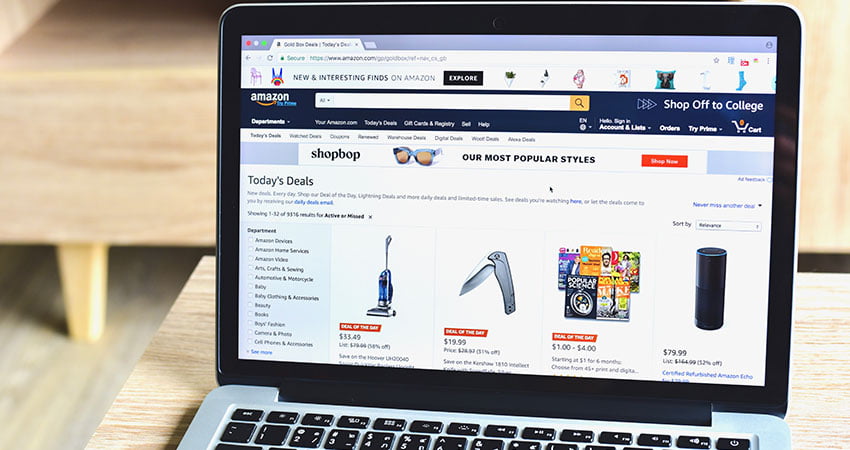Amazon is the world’s most valuable brand and has an estimated 38% of ecommerce sales in the U.S., forcing business owners to acknowledge that a brand presence on the Amazon marketplace is essential for growing an online business.
Unfortunately, Amazon’s increasing popularity with consumers and sellers has its growing pains. The almost 3 million sellers flocking to Amazon makes capturing shoppers’ attention exceptionally challenging. Now, advertisers must spend more with a lower probability of conversion. In the last year, our data shows a 38% rise in the average cost-per-click for sponsored product ads and a 36% fall in the average conversion rate. To stand out from the crowd, more brands are utilizing sponsored ads.
Based on our whitepaper, The State of Amazon Marketing: Increased Marketplace Saturation Demands A Proactive Strategy, here are six takeaways for marketers charged with growing your company’s ecommerce business on the Amazon marketplace.
Marketing
Use Marketplace SEO
Search engine optimization (SEO) is the foundation of marketplace marketing. All organic and paid marketing efforts guide shoppers to your product detail pages, so it’s vital that your listings are primed for conversion.
This involves optimizing front-end and back-end keywords with highly-searched, low-competition keywords. Keyword density must be balanced with readability. A first-page listing is useless if shoppers bounce due to an unintelligible string of keywords in the listing. Write for the audience first, then insert keywords where they naturally fit. When done well, we’ve seen listing optimizations increase conversions by up to 50%.
Consider Search Marketing Optimization Software
While the average cost of sponsored ads on the Amazon marketplace is rising, they remain a key component in an overall marketplace strategy. Foregoing sponsored ads can reduce competitive impact as they remain a profitable marketing service. Just how profitable is dependent on your strategies and tools. Ensuring that sponsored ads generate maximum return requires around-the-clock strategic adjustments to bids and keywords.
An ad management software will automate this constant, time-intensive process for optimum results. There are a growing number of ad management solutions out there, so do your homework. Selecting right software will more than offset the investment.
Off-Marketplace Marketing to Increase Marketplace Traffic
Nearly half of online shoppers begin their search on Amazon. That’s an enormous percentage for one marketplace, but it’s still only half. How do you reach the other half? Social media.
Almost 70% of U.S. adults use Facebook, making social media an effective way to extend brand reach. Paid social ads, organic social media engagement, paid influencer marketing, and micro influencers are fantastic assets in your Amazon marketing campaign because they increase listing traffic, grow awareness, foster brand loyalty, and keep your brand top-of-mind.
The combination of the above three strategies drives off-site and on-site traffic to listings that are primed to convert, maximizing sales.
Brand Protection
Take Steps to Protect Your IPR
One of the most effective strategies you can take for protecting your brand is filing trademarks, patents, and copyrights to protect your international property rights (IPR). Fighting counterfeits and copycat products is significantly more difficult when you don’t have legal footing. Take the time to file the paperwork and give your business a strong foundation, which will save you from future stress and financial risk.
Utilize Amazon’s programs for brand protection
Amazon offers several programs that help brands protect themselves on Amazon, including Brand Registry, Brand Gating, Transparency and Project Zero.
Brand Registry helps brands defend against IPR violations through Amazon’s infringement reporting tool. It also enables brands and their Registered Agents to accelerate listing updates, create A+ Content and Brand Stores, access Amazon Live, and access Amazon’s Attribution beta.
Brand Gating is an invite-only Amazon service that prevents sellers from listing specific Amazon Standard Identification Numbers (ASINs), unless they provide an authorization letter. To increase your likelihood of being invited into the program, you must first become Brand Registered. Once registered, always report violations through Amazon.com, and submit a formal list of ASINs you’d like gated.
The Transparency program labels products with unique QR codes provided by Amazon (for a fee). When an Amazon warehouse receives product enrolled in Transparency, they scan the QR codes to verify the product is from your approved manufacturer. If it is not, the product is counterfeit, and will be removed and destroyed.
Project Zero is Amazon’s effort to snuff out counterfeiters by enabling brands to remove counterfeit listings themselves. This method bypasses the Amazon case system, giving brands an enormous amount of power. Currently, the program is invite-only. Brands interested in Project Zero can join the waitlist to be notified when they are eligible to enroll.
Seller and Distributor Contracts
Contracts often give sellers and distributors full legal rights to resell or distribute to anybody they choose. Before signing agreements or even upon renegotiation, consider adding clauses that better align with your strategy. For example, look at protections regarding to whom goods can be sold, where goods can be sold online, if they can be sold internationally, etc.
Protecting your brand on on the Amazon marketplace requires proactive and reactive strategies. The less you do of one, the more you’ll have to do of the other.
Kunal Chopra is CEO of etailz, Inc.
